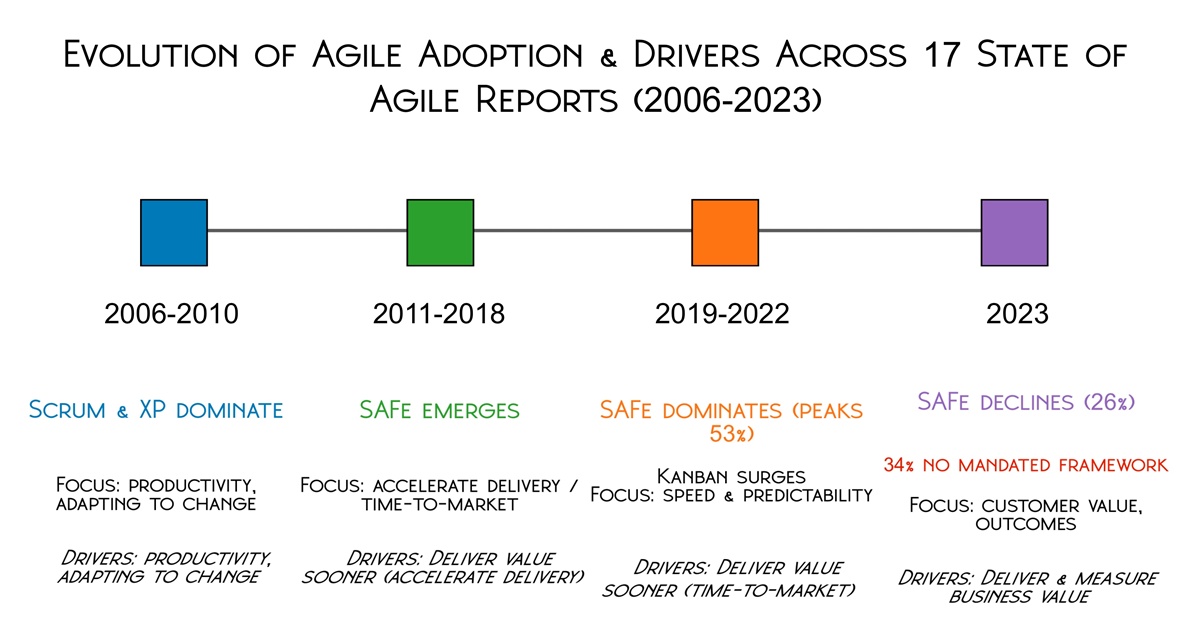
Digital AI releases an annual "State of Agile" report which I am eagerly anticipating. While I wait for the 18th report to be released, I want to take a moment to look at how we have talked about Agile has changed over time.
In the early versions of the report, Agile was mostly about teams. Scrum and XP were the stars, and the big wins came from productivity, transparency, and adapting to change. The message was simple: Agile helps teams deliver better and faster than waterfall.
Over the years, though, the conversation has shifted. Agile scaled up and moved into the enterprise but delivering value sooner has remained the main reason that organizations have adopted Agile over time. Each State of Agile report tells us something about what organizations care about—and if you look at all 17 together, you can see clear trends that reveal where Agile has been and where it’s heading.
1) Why We Adopt Agile
Across all 17 reports so far, the number one reason (or tied for first) has been something along the lines of "deliver value sooner", although the 17th report changed that wording to be "Prioritize, deliver, and measure incremental customer and business value" which was a shift towards a focus on business value delivered incrementally. When we say incremental delivery, that still maintains the idea of delivering value sooner (because it is delivered in smaller, usable pieces) but the top reason now includes business outcomes, which I consider a very positive step forward. That shift from just delivering sooner to delivering sooner + outcomes is important.
2) Scaling Frameworks Rise—and Fall
The first reports didn’t say much about scaling frameworks. Scrum dominated at the team level, with XP and later Kanban joining the mix. But as enterprises got serious about scaling, SAFe surged. By the 16th report, it was at 53% adoption, far outpacing any other scaling framework. And then? The most recent report shows SAFe dropping to 26%, while over a third of organizations now say they use no mandated scaling framework at all.
3) The Framework that Sticks
Despite all the noise about scaling (everyone loves to talk about scaling, after all!), the foundation hasn’t changed: Scrum is still the most-used framework in every report. Kanban has surged too, becoming a staple alongside Scrum. What’s striking is how teams blend practices - Scrum with Kanban is the most popular. The lesson here is simple: while scaling frameworks come and go, the heartbeat of Agile is still at the team level and Scrum has stood the test of time (I may be biased but the data is bearing me out here.)
4) Barriers Shift Upward
Early reports said the biggest challenges were lack of training and lack of experience. Those are team-level problems. But more recent reports point to leadership, culture, and alignment as the current barriers. Agile has already proven itself on the ground. The sticking points now are at the top—executives not fully on board, business and IT not aligned, or organizations clashing with cultural resistance. The evolution of barriers tells us Agile’s biggest challenges are no longer about “how to do standups,” but about “how to make the whole company Agile.”
5) Focus on Value
At the end of the day, every State of Agile report brings us back to the same point: Agile is about delivering value sooner. Whether it’s framed as speed, time-to-market, or measurable business outcomes, the theme hasn’t changed although it has shifted more to business outcomes which - again - is a positive step. What has changed is the sophistication of how we talk about it. We’ve gone from “deliver faster” to “deliver smarter.” Agile has grown up. It’s not just a way of building software—it’s a way of aligning the entire organization around value.
Conclusion
After 17 reports, the story of Agile is one of continuous improvement. From teams to enterprises, from speed to outcomes, from practices to culture. The reports show us that Agile isn’t static—it adapts, just like it teaches us to. And as we look ahead to the 18th report, one thing is certain: the conversation will keep changing. Because Agile isn’t just about where we’ve been—it’s about how we keep moving forward.
___________
Rebel Scrum is the host of the annual Scrum Day Madison Agile conference.
